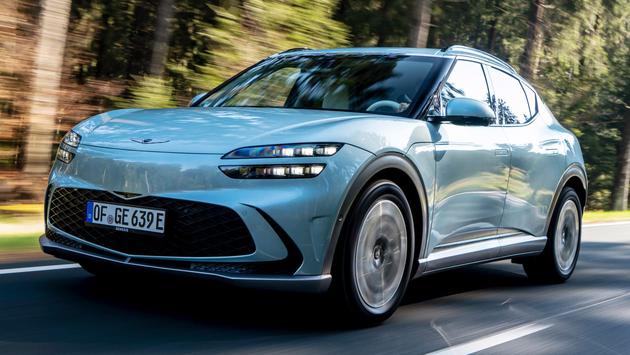► The first electric Genesis tested
► Early pre-production first drive
► 289-mile range, up to 483bhp
Can you tell this is a pre-production car? What gave it away?
This is the very-nearly-ready GV60, the first electric car from Genesis, set for launch in Europe in the coming weeks. The Sao Paolo Lime paintwork will be an option; the stickers won’t be.
When it does land in the UK (deliveries are expected tobegin this summer), prices will start from £47k for the single-motorentry-level model, up to £65k for the top-spec, twin-motor,all-wheel-drive Sport Plus version this test car is equivalent to.
Genesis is linked with Hyundai, right? So is the GV60 related to the Ioniq 5?
It’s twinned (or rather tripletted) with the Hyundai Ioniq 5 and the Kia EV6, using the sameE-GMP platform.That means a great deal of interior space, rapid-charging capability(Genesis claims 10 to 80 per cent in 18 minutes via a 350kW charger),and dramatic proportions.
The Genesis wears its rounded lines differently from theangular, retro Hyundai and wedgy, hot-hatchesque Kia, which are muchbigger in real life than they appear in pictures. The GV60 looks itssize, and feels more like a traditional crossover in proportion. It’sstill an arresting design, with a sweeping roofline (yet plenty of rearheadroom), and intricate alloy wheels (21-inchers on this car) poppingfrom the arches.
E-GMP showdown: Ioniq 5 vs Kia EV6
In line with the Genesis brand’s upmarket positioning,and the GV60’s luxurious spec, it’s more expensive than its sister cars.At the time of writing, the Ioniq 5 ranges from under £38k to £46k, andthe Kia EV6 from under £42k to £54k.
It’s the first electric Genesis but not the last. Thecompany plans for all new Genesis models to be fully electric by 2025,and for its non-electric cars to be phased out by 2030.
Luxurious how?
Step inside and it feels and smells upmarket, with highquality leather, suede and ornate, but not showy, metal trim withimpressive fit and finish (by any standards, not just for apre-production car).

The design individualism continues from the inside, withlozenge and chevron themes. And some unusual touches: the floatingcentre console is inset with what appears to be a crystal ball, lit fromwithin. Press the start button and it flips over to become a twist ’n’go gear selector for Reverse, Neutral and Drive. Beneath the consolethere’s plenty of oddments space, and more in a stowage bin under thedash. The roominess is accentuated by the flat floor. Your phone can betucked away in a wireless charging spot within the centre console, whichneatly obscures the screen from view so you don’t get distracted bynotifications while you’re driving.
Best electric SUVs
On the downside, the driving position is extremely high,even by crossover standards, and the steering wheel doesn’t adjust farenough to compensate. Look to the mirrors and you find they’re actuallycameras on stalks, with screens at the junction between the base of theA-pillars and doorcards (although that will be an option in the UK, withconventional mirrors standard).
What’s it like to drive?
Smooth, rapid and quiet too, admirably refined at acruise. Only downside is the soggy handling, with this pre-prod car’ssuspension set-up a hotchpotch of Korean and USA settings. Hit a bumpand the car continues to wobble, jelly-like, for some distanceafterwards. European cars are set to get a more well resolved set-up(and need it).
It’s certainly fast, with a temporary shot ofmaximum-torque acceleration available via the Boost button on thesteering wheel. It makes the accelerator pedal so sensitive it’s worthbracing yourself beforehand – it really is very accelerative in thismode. In fact, there’s quite a marked step in pedal sensitivity betweeneach of the driving modes.
How well does the cameras-for-mirrors set-up work?
It takes a few miles to adapt to. At first you mightfind your eyes naturally darting to the camera stalks the other side ofthe window glass, where the mirrors would be, rather than to the screenswithin the car (which are mounted at the junction between the bottom ofthe interior-side A-pillar and the top of the doorcard.
There’s more refocusing time between fixing your gaze onthe screens and readjusting it to the landscape beyond the windscreenahead, and if you’re wearing sunglasses on a bright day, that darkensthings a little compared with looking out at conventional glass mirrors.At night there’s a certain amount of glare from car’s headlights andstreetlamps behind, too.
But none of these factors are complete deal-breakers. Asthe miles tick by, you become more and more accustomed and before toolong you’ll likely find them just as usable as regular mirrors.Superimposed graphics help judge the distance to vehicles behind, whichhelps with getting your bearings.
There’s a further camera function in that when youindicate, a blind-spot camera display appears on the instrument panel.Together with all-round parking cameras displayed on the largetouchscreen, it’s a relatively easy car to manoeuvre despite the naturalblindspots of its large C-pillars.
How efficient is the GV60?
We covered more than 400 miles during our test, duringwhich this car shows itself capable of travelling more than 230 milesbetween charges, including a great deal of motorway and A-road driving.That compares favourably with the on-paper range of 289 miles for thisspec GV60. It’s not possible to rapid-charge this pre-production car(and so a fair bit of time was spent plugged in) but it’s claimedcustomer cars will be capable of 350kW rapid-charging from 10 to 80 percent in 18 minutes.
Levels of energy regeneration can be increased anddecreased by gearshift-style paddles behind the wheel, from coasting toone-pedal driving.
Anything else I should know?
The infotainment set-up is superb. The large,ever-so-slightly curved touchscreen has an uncluttered and pin-sharpdisplay that’s intuitive to use. Aside from prodding the screen, you canalso access short-cut keys at easy reach on the centre console, or use aclickwheel (with a trackpad for scribing in postcodes and so on) justbehind it. Together with voice control (which worked averagely well inthis test car), there are four ways of executing a command, and each ofthem feels easy and natural.
To me, this feels a much better execution of a modern interface than BMW’s latest iDrive system in the iX.
Genesis GV60: verdict
This already feels like a thoroughly convincing upmarket EVcrossover, even in pre-production form. Different and interesting, in agood way – there’s much to like here.
If Genesis’s large and resolutely combustion-powered initial launchmodels in the UK felt very much like niche products, the GV60 has thepotential to appeal to a truly wide audience (albeit a relativelydeep-pocketed one, given its price premium over other E-GMP cars).The clean-slate EV paradigm shift for consumers means that the old,established brands are no longer an obvious choice. For Genesis to gain afoothold in the UK, the GV60 feels a perfect car, and an extremelycredible one.
No star ratings for now, given the unfinished status ofthis test car, but the production model could well score very highly.Stay tuned for the full verdict in a few short weeks.




